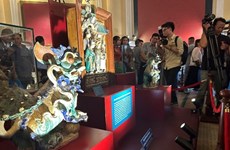Exhibition features beauty of the lotus flower
A collection of 100 objects dating back to the 7th century of the
Nguyen Dynasty (1802-1945) which feature the lotus flower is on display
at the Vietnam National Museum of History in Hanoi.
A collection of 100 objects dating back to the 7th century of the
Nguyen Dynasty (1802-1945) which feature the lotus flower is on display
at the Vietnam National Museum of History in Hanoi.
The exhibition, Lotus and Antiquities, is to introduce local and international visitors to the beauty and significance of the lotus in Vietnamese culture.
Among the thousands of objects that live in the halls of the Vietnam National Museum of History, lotus flower decorations dominate the visual landscape, said Museum Director Nguyen Van Cuong.
There is no object on which the flower cannot be found – paintings, statues, jewels, worship objects, architectural materials and even household utensils.
"The lotus theme is presented in various motifs and different artistic styles. It appears not only on objects made of stone, pottery, paper, textile fabric and wood, but also on precious materials such as gold, silver, jade and ivory," said Cuong.
The exhibition, divided into several categories, explores the iconic flower through the ages.
In the Lotus in Royal Arts of the Nguyen Dynasty section, shelves are full of delicate ornaments of jade, ivory and precious metals used by royalty. Imagine swords, washing trays, crowns and jewelry boxes covered in lotus flowers.
In the Lotus in Buddhism and Rituals section, 11th to 20th century Buddha statues sitting atop lotus pedestals or incense burners in the shape of lotus leaves are numerous.
Dr. Pham Quoc Quan, member of the Vietnam National Cultural Heritage Council, explained: "In Buddhism, the lotus flower represents purification, faithfulness, compassion, wisdom and enlightenment."
"The lotus is symbolic of transparency in Vietnamese culture. It also represents the refined and unyielding spirit of the Vietnamese people," he said, therefore, "the lotus can be found in a number of decorative materials and antiques throughout Vietnamese fine arts."
For example, the section, Lotus in Architectural Decoration, displays pillars, pedestals, tiles and bricks dating from the Ly and Tran dynasties (10th to 14th century), and Lotus in Ordinary Life, places the icon on objects of quotidian life – jars, boxes and trays.
The ubiquity of the lotus is unavoidable.
The exhibition will run until the end of September.-VNA
The exhibition, Lotus and Antiquities, is to introduce local and international visitors to the beauty and significance of the lotus in Vietnamese culture.
Among the thousands of objects that live in the halls of the Vietnam National Museum of History, lotus flower decorations dominate the visual landscape, said Museum Director Nguyen Van Cuong.
There is no object on which the flower cannot be found – paintings, statues, jewels, worship objects, architectural materials and even household utensils.
"The lotus theme is presented in various motifs and different artistic styles. It appears not only on objects made of stone, pottery, paper, textile fabric and wood, but also on precious materials such as gold, silver, jade and ivory," said Cuong.
The exhibition, divided into several categories, explores the iconic flower through the ages.
In the Lotus in Royal Arts of the Nguyen Dynasty section, shelves are full of delicate ornaments of jade, ivory and precious metals used by royalty. Imagine swords, washing trays, crowns and jewelry boxes covered in lotus flowers.
In the Lotus in Buddhism and Rituals section, 11th to 20th century Buddha statues sitting atop lotus pedestals or incense burners in the shape of lotus leaves are numerous.
Dr. Pham Quoc Quan, member of the Vietnam National Cultural Heritage Council, explained: "In Buddhism, the lotus flower represents purification, faithfulness, compassion, wisdom and enlightenment."
"The lotus is symbolic of transparency in Vietnamese culture. It also represents the refined and unyielding spirit of the Vietnamese people," he said, therefore, "the lotus can be found in a number of decorative materials and antiques throughout Vietnamese fine arts."
For example, the section, Lotus in Architectural Decoration, displays pillars, pedestals, tiles and bricks dating from the Ly and Tran dynasties (10th to 14th century), and Lotus in Ordinary Life, places the icon on objects of quotidian life – jars, boxes and trays.
The ubiquity of the lotus is unavoidable.
The exhibition will run until the end of September.-VNA













